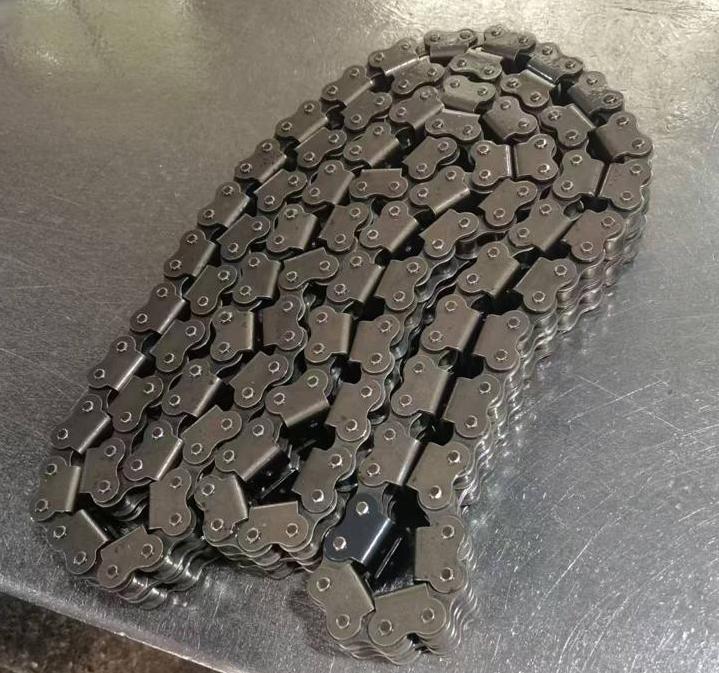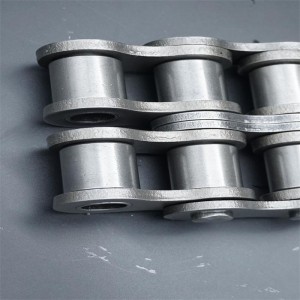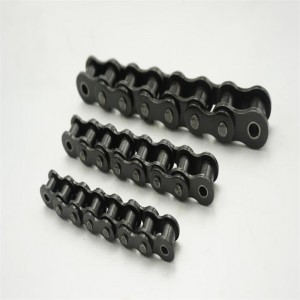Roller Chain 12A
Product Features and Advantages
1. Precision structure and high-strength material
The roller chain 12A is made of high-quality alloy steel or carbon steel, and undergoes a strict heat treatment process to ensure the high strength and wear resistance of the chain. The inner chain plate and sleeve, the outer chain plate and the pin are interference fit, while the roller and sleeve, and the sleeve and the pin are clearance fit. This design allows the chain to rotate flexibly during operation while reducing wear.
2. Efficient transmission performance
The pitch of the roller chain 12A is 19.05mm, the roller diameter is 11.91mm, the inner width of the inner link is 12.57mm, and the pin diameter is 5.94mm. These precise dimensional designs ensure the perfect fit between the chain and the sprocket, thereby achieving efficient power transmission. Its average tensile load can reach 41.5kN, and the ultimate tensile load is 31.8kN, which can withstand a large workload.
3. Durability and low maintenance cost
The pins and sleeves of roller chain 12A are surface hardened to maintain stable operation under high pressure and withstand the pressure generated by the load. In addition, the rollers are made of high-carbon titanium steel and seamless sleeves, which are quenched to further improve wear resistance and tensile resistance. This design not only extends the service life of the chain, but also reduces maintenance costs.
4. Wide applicability
Roller chain 12A is suitable for a variety of industrial scenarios, including machinery manufacturing, food processing, packaging equipment, agricultural machinery and automobile manufacturing. Whether it is a single-row, double-row or multi-row design, it can meet the transmission needs of different equipment.
5. Diverse surface treatment
Roller chain 12A provides a variety of surface treatment options, such as shot blasting, galvanizing, nickel plating, etc., to adapt to different working environments and anti-corrosion requirements. These treatments not only enhance the corrosion resistance of the chain, but also improve its aesthetics.
6. International Standard Certification
Roller chain 12A complies with international standards such as ISO, ASME/ANSI, and JIS, ensuring its universality and interchangeability worldwide. This standardized design allows the chain to work seamlessly between different equipment and sprockets.
FAQ
1. What scenarios are roller chain 12A suitable for?
Roller chain 12A is widely used in industrial transmission fields, including machinery manufacturing, food processing, packaging equipment, agricultural machinery, and automobile manufacturing. It is particularly suitable for equipment that requires high-precision and high-load transmission.
2. How to choose the appropriate length of roller chain 12A?
The length of roller chain 12A is usually expressed in the number of sections. It is recommended to select the appropriate number of sections according to the specific needs of the equipment and the size of the sprocket. If an odd number of sections is required, a transition link can be used, but try to design it to an even number of sections to ensure optimal transmission performance.
3. Does roller chain 12A need regular lubrication?
Yes, roller chain 12A needs regular lubrication to extend its service life and ensure efficient operation. It is recommended to apply sufficient lubricating oil on the pins and sleeves, and formulate a lubrication plan according to the working environment and frequency of use of the equipment.
4. Can roller chain 12A be customized?
Yes, many suppliers provide customized services for roller chain 12A, including different number of sections, surface treatment and special design. You can contact the supplier according to your specific needs.
5. How to calculate the life of roller chain 12A?
The life of roller chain 12A is affected by many factors, including load, speed, lubrication conditions and working environment. Generally speaking, its service life can be significantly extended through regular maintenance and lubrication. The specific life calculation needs to be combined with the actual operating conditions of the equipment.





